摘要
Lepidium meyenii Walp. (maca), a perennial herbaceous plant with narrow distribution in. the Andean region, was cultivated by local residents as early as 1600 BC. It has high nutritional value and multiple medicinal effects. The plant source of maca is now scarce because maca products are becoming increasingly popular in the world as dietary supplements. This means that studies on the identification of maca materials are now urgent. In present work, natural plants with similar appearance or medicinal effects, including maca, radish (Raphanus sativus L.), oriental ginseng (Panax ginseng C. A. Mey.), American ginseng (Panax quinquefolium L.) were investigated. Their alkaloid extracts of the hypogeal parts were analysed by FTIR and TLC. The essential oils (steam distillates) were analysed by GC/MS. Through comparison of the characteristics of their spectra and chromatograms, it was found that the functional ingredient extracts of maca have unique FTIR, TLC and GC/MS behaviours. The secondary amide group (-CH2-NH-CO-CH2-) and the phenyl structure in FTIR, the multiple spots at different R-F values colourised by modified Dragendorff's reagent, and the characteristic peaks produced by the major essential oil components (e.g. phenylacetonitrile, benzaldehyde, 3-methoxyphenylacetonitrile) in GC/MS are distinct. These behaviours can be applied to the identification of maca or maca products in the market.
- 出版日期2007-9
- 单位华中科技大学
